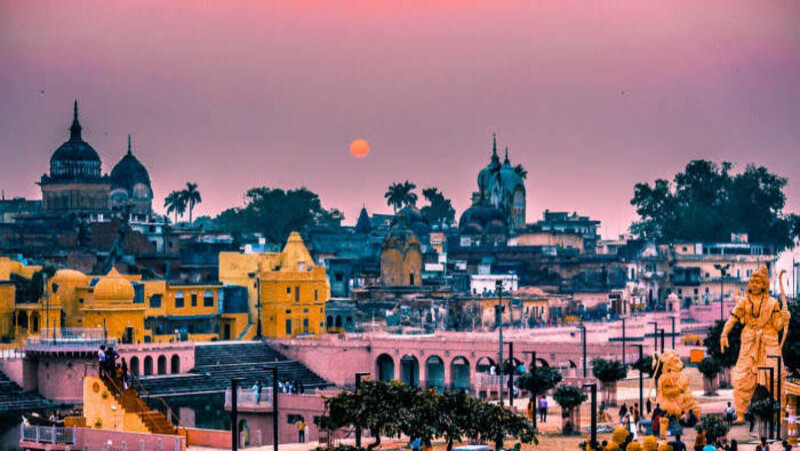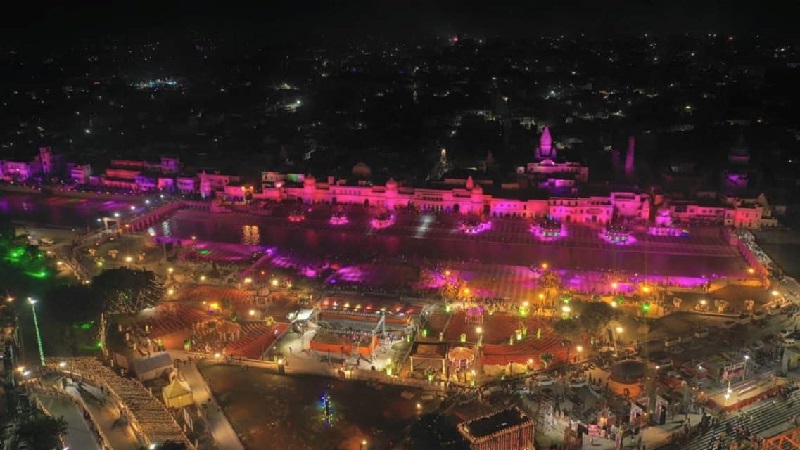Varanasi Ayodhya Prayagraj Tour

Ayodhya Tour Guide
Ayodhya, situated in the state of Uttar Pradesh, is an ancient city steeped in rich cultural and religious history. Renowned as the birthplace of Lord Rama, Ayodhya has lot of significance for millions of people worldwide.
Significance - Historical and Cultural
Ayodhya is one of the seven sacred cities for Hindus. It has been a main Hindu pilgrimage site for centuries. The city’s history is intertwined with the epic Ramayana, which narrates the life and adventures of Lord Rama. According to Hindu mythology, Ayodhya was established by the legendary king Manu. It later became the capital of the Ikshvaku dynasty, to which Lord Rama belonged.
Ayodhya city, situated in the heart of Uttar Pradesh, holds profound historical and cultural significance deeply rooted in Hindu mythology. Its roots extend to the ancient Ikshvaku dynasty. The city, mentioned in various ancient texts, became the centre of the revered Sanskrit epic, the Ramayana. This epic narrates the life and adventures of Lord Rama.
The history of Ayodhya city includes the Ayodhya dispute. This is a contentious issue surrounding the Ram Janmabhoomi, believed to be the birthplace of Lord Rama. The Babri Masjid, constructed in the 16th century, stood on this site until its demolition in 1992. This reason led to a prolonged socio-political debate. In 2019, the Supreme Court of India ruled in favour of the construction of a Hindu temple on the disputed land.
Today, Ayodhya stands as a real example to India’s cultural and religious heritage. Pilgrims, historians, and devotees converge on this sacred city, exploring its temples, ghats, and main points that vouch the past and stand tall high in present.

Places to Visit in Ayodhya
Ayodhya, the ancient city seeped in mythological lore, is home to various temples, ghats, and historical sites. Here is a detailed exploration of the places to visit in Ayodhya:
Ram Janmabhoomi
Ram Janmabhoomi, situated in Ayodhya Uttar Pradesh, holds high religious significance. It is believed to be the birthplace of Lord Rama, a revered deity in Hinduism. While the area is primarily known for the newly constructed Ayodhya Ram Mandir Uttar Pradesh, the site has several places to visit that encapsulate the historical and spiritual essence of Ayodhya Ram Janmabhoomi.
Hanuman Garhi
Located at the top a mound and overlooking the sacred city of Ayodhya, Hanuman Garhi stands as a revered temple dedicated to Lord Hanuman. The temple, situated in an elevated position, is a significant pilgrimage site for devotees who ascend a flight of stairs to reach the sanctum. The deity here is portrayed as a vigilantly seated Lord Hanuman, ever watchful and ready to protect. Apart from its religious importance, From the Hanuman Garhi one can see the breathtaking panoramic views of Ayodhya.
Sarayu River Ghats
The banks of the Sarayu River and high pitch Saryu Aarti near Ram Janmabhoomi provide serene surroundings for reflection and prayers. Pilgrims often take a dip in the holy river as part of their spiritual rituals.
Kanak Bhawan
Kanak Bhawan is a beautiful Hindu temple dedicated to Lord Rama and Sita. This ornate temple is renowned for its exquisite architecture. It houses the divine idols of Lord Rama and Sita, adorned in gold. According to Hindu mythology, the temple was a gift from Queen Kaikeyi to Sita during her wedding to Lord Rama. Devotees gather and visit to Kanak Bhawan to seek the blessings of the divine couple and experience the spiritual ambience that permeates the quite halls.
Choti Chhavani
Choti Chhavani, situated in Ayodhya, holds special significance as it is believed to be a sacred spot associated with the ancient palace of Lord Rama. This revered site is marked by an ancient banyan tree that stands as a living witness to the legends of the Ramayana. Pilgrims and devotees visit this spot to pay their respects and offer prayers. This helps them feel a deep connection to the historical and mythological events linked to Lord Rama’s life.
Treta Ke Thakur
Treta Ke Thakur, a revered site in Ayodhya, is believed to be the location where Lord Rama performed the Ashvamedha Yajna. This sacred spot, having historical and mythological significance, attracts pilgrims and devotees seeking to connect with the divine legacy of Lord Rama. The name “Treta Ke Thakur” is derived from the Treta Yuga, one of the four cosmic ages in Hinduism. Pilgrims visiting this site partake in rituals and prayers, immersing themselves in the profound spirituality associated with the historical events that transpired here.
Swarg Dwar
Swarg Dwar, meaning the “Gateway to Heaven”, is another revered site in Ayodhya. According to the ancient texts, Swarg Dwar is the spot from which Lord Rama is said to have entered heaven. Pilgrims and devotees visit Swarg Dwar to pay homage to this sacred site, seeking spiritual blessings and a connection with the divine. The name itself carries a profound significance, symbolising the transcendence of Lord Rama from mortal existence to the celestial realm.
Nageshwarnath Temple
Nageshwarnath Temple is another revered Hindu shrine dedicated to Lord Shiva. One of the oldest temples in Ayodhya, it stands as a testimony to the city’s rich cultural and religious heritage. The temple is believed to have been established by Kush, the younger son of Lord Rama. Devotees and pilgrims visit Nageshwarnath Temple to seek the blessings of Lord Shiva and participate in religious ceremonies during the festival of Shivaratri.
Gulab Bari
Gulab Bari is a historic garden complex that bears testimony to the city’s rich cultural and architectural heritage. The literal translation of Gulab Bari is “Garden of Roses,” and it lives up to its name. Its enchanting landscape is adorned with a profusion of vibrant flowers, particularly roses. The garden is home to two prominent structures—the Gulab Bari, which is a magnificent tomb dedicated to Nawab Shuja-ud-Daula, and the Baoli, an ancient stepwell. Nawab Shuja-ud-Daula, a prominent noble in the 18th century, played a significant role in the development of Ayodhya. The Gulab Bari complex is characterized by its Mughal-style architecture, arched doorways, and lush greenery, creating a serene and picturesque setting.
Mani Parbat
A tiny hillock called Mani Parbat stands tall at a height of 65 feet above sea level in Kami Ganj, Ayodhya. It stands as a scenic viewpoint for the city, and also houses a Buddhist Monastery, and a stupa built by King Ashoka. An Islamic mausoleum also stands at the foothills of Mani Parbat.
Ram Katha Park
Ram Katha Park, situated in Ayodhya, is a cultural complex dedicated to the timeless epic Ramayana. This park serves as a vibrant hub for events, performances, and gatherings that revolve around the narrative of Lord Rama. The park features intricate sculptures and dioramas depicting pivotal scenes from the Ramayana. It also serves as an educational space where visitors can immerse themselves in the rich cultural heritage of Ayodhya.
Ayodhya, a location with its own history, spirituality, and cultural richness, is a testament to India’s diverse heritage. From the revered Ram Janmabhoomi to the cultural celebrations of Diwali and Ram Navami, Ayodhya offers a great experience for pilgrims, history enthusiasts, and those seeking spiritual holiday.
In Nutshell Ayodhya lies not just in its physical landmarks but in the cultural tapestry that binds its own community and tourist, making it a timeless location .